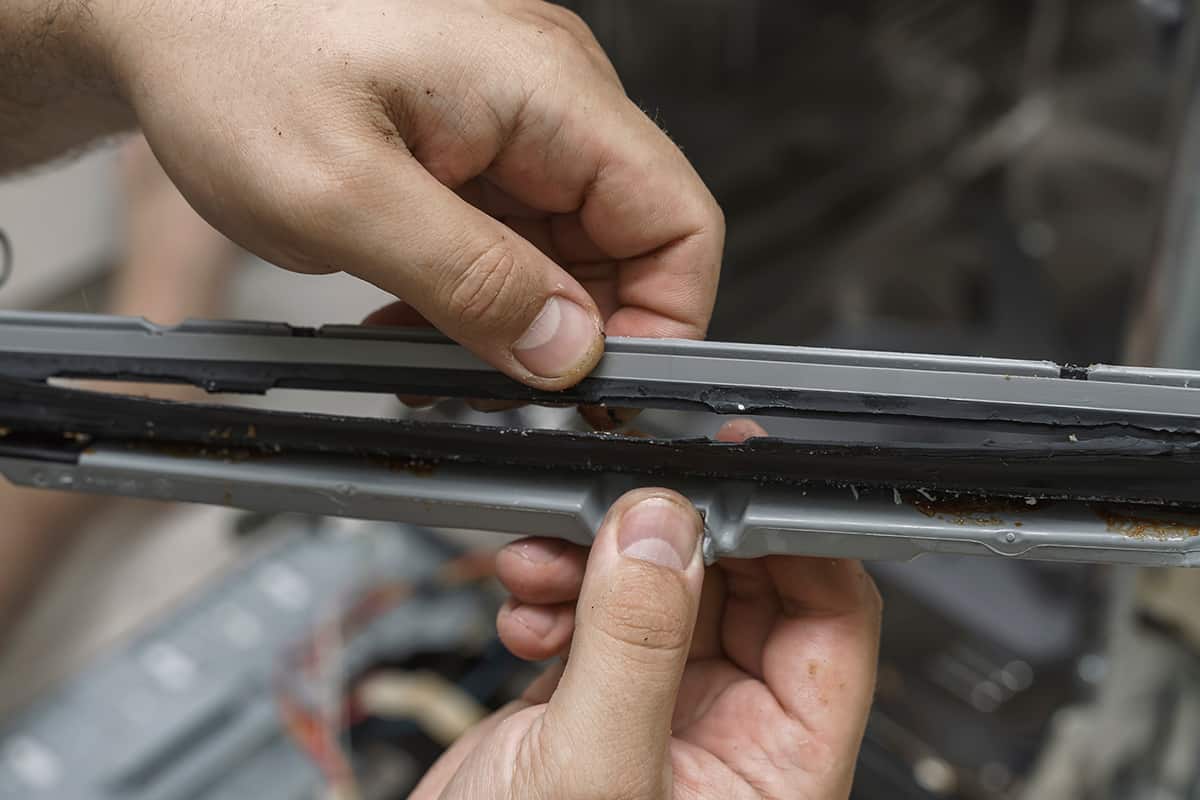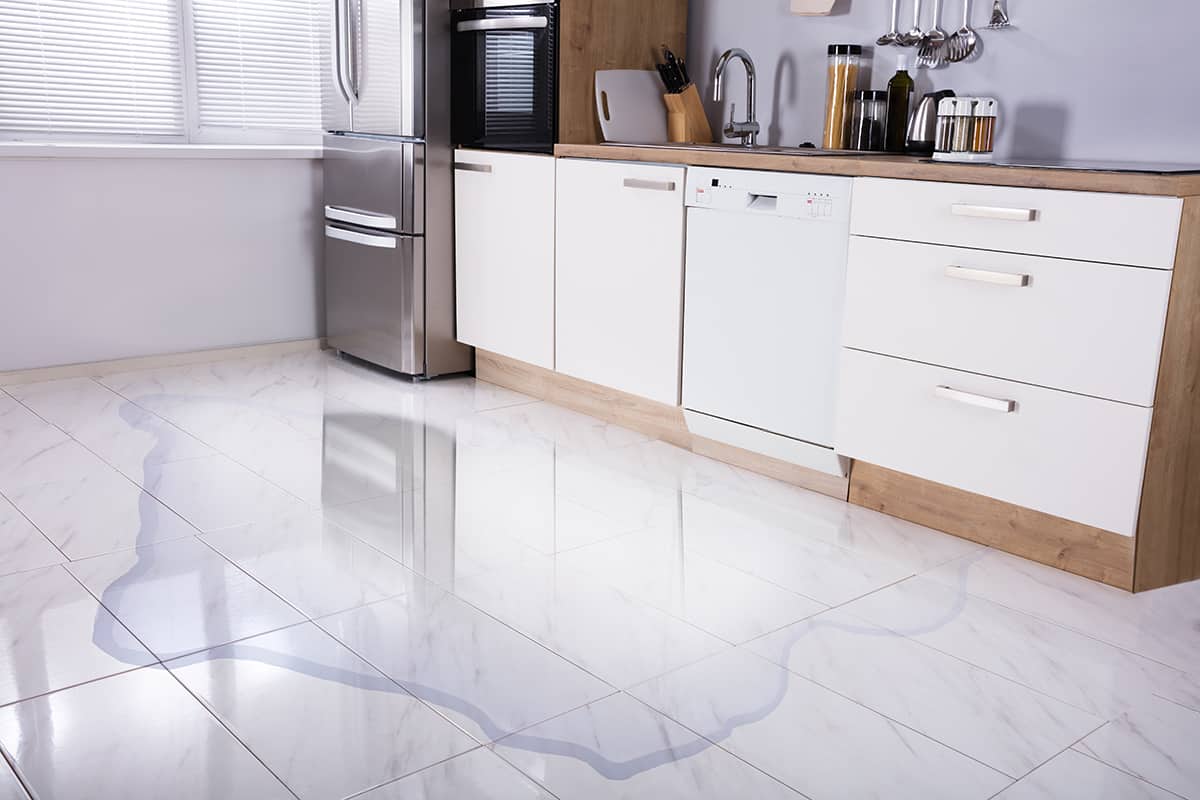A leaking dishwasher is definitely a cause for concern. All dishwashers are designed with leak-proof seals that keep moisture inside the tub. However, over time, you might notice droplets of water making their way out of the dishwasher, even when the machine isn’t in use.
If your dishwasher leaks water, even when it’s not running, it might be a sign that the machine is in need of repairs. There are multiple causes of this issue, including a damaged water inlet valve, blockages in the drain hose or filter, and even an unlevel dishwasher.
However, the causes mentioned above only scratch the surface of the problem. If you’d like to know more about why your dishwasher leaks when not running, as well as how to resolve the problem, you’ll find all the answers down below.
What Causes a Dishwasher to Leak When Not Running (and How to Fix)?
Dishwashers are designed with anti-leak seals around the doors and hose connections. So, if your dishwasher is leaking water, regardless of whether or not it’s on, then the machine might be in desperate need of repairs.
Below, I’ll describe the various causes that could be associated with leakage problems in dishwashers. There are far too many to describe in a single guide, but I will cover the likeliest root causes of leaking problems.
Faulty Water Inlet Valve

The water inlet valve is the only way a dishwasher can receive water. If the valve has become damaged over time, which is a likely scenario if your dishwasher is older than five years, then you might need to replace the valve completely.
However, that is only in very extreme instances. Many times, while installing the dishwasher, you might not have used enough Teflon tape or thread seal tape when connecting the valve to the machine. So, the first thing you should do is inspect the valve for damage and add more Teflon tape if needed.
Imbalanced Alignment
Dishwashers come with adjustable feet that you twist to raise or lower the corners. These feet are in place to ensure that the dishwasher’s tub sits perfectly parallel to the floor. If, for whatever reason, one of the dishwasher’s legs has become too tall or too short, water may pool in a certain part of the dishwasher and leak out of any crevices it can find.
If one of the legs is too short even after extending it to its fullest height, then you should place shims underneath it.
Damaged Tub

Although dishwasher tubs are designed to last thousands of wash cycles, it’s not built to last forever. As such, the stainless steel that goes into the tub may lose its anti-corrosive coating with time, which may lead to oxidation and rusting that will eventually tear a hole in the tub. This might be a result of using improper dish detergent, pods, or tablets.
While you can fix the tub, it might be a better idea to replace it entirely. After all, replacing the chromium coating can be a bit costly, as is removing the tub and replacing it with a new tub. If there’s a hole in the tub that causes water to leak out of the machine, I recommend replacing the entire dishwashing unit.
Overloaded Dishracks

Your dishwasher is designed to accommodate a certain number of place settings, and exceeding the limit might cause water to pool in the pots, pans, and bowls. When the wash cycle ends, the water might end up pouring out of the machine.
Take a look at the owner’s manual to learn how to properly load the dishracks in your dishwasher. If you lost the manual, take a look at the manufacturer’s website for a digital version and pay careful attention to how to load the dishracks.
Limescale Buildup
If the water inlet valve supplies hard water to your dishwasher, then you will have to routinely examine the water and drain lines for limescale buildup. The buildup will look solid but have a chalky texture. The blockage can prevent water from draining out of the machine properly, causing standing water at the bottom of your tub that has nowhere to go but out the door.
Removing limescale buildup from a dishwasher is as easy as dropping a using a dishwasher cleaner on the entire interior surface of your dishwasher. You can also use a 1:4 vinegar and water solution to remove the limescale by pouring it into your machine, letting it sit for 30-60 minutes, then running an empty rinse cycle.
Damaged Door Seal

The door seal, also known as the gasket, is the silicone lining along the exterior edge of the door. It serves to keep moisture inside the dishwasher whenever the door is closed. Routinely running the washing machine will keep the seal adequately moistened, but if you’ve left your dishwasher dormant for weeks at a time, the seal might begin to dry out. And when it dries out, it might fail at preventing moisture from seeping out.
If you notice cracks or tears in the seal, you might have to tear it out and replace it completely. Replacements are fairly inexpensive, and it’s quite simple to do (this video by PartSelect explains how to do it).
Clogged Filter Assembly
The filter assembly is the 3-piece filter that prevents solid debris from clogging your garbage disposal and sewer line. After multiple wash cycles, your dishwasher might become clogged with mesh filters becoming full of old food remnants that need to be removed to allow water to drain properly. Failing to do so might lead to standing water, which can leak out of your dishwasher.
You can clean a dishwasher filter assembly by removing the assembly from the bottom of the dishwasher, soaking it in soapy water, then gently brushing the filters until they’re perfectly clean.
Loose Drain Hose
The drain line connects to your garbage disposal or kitchen sewer line. Any water that makes it past the filter assembly will get flushed out. One problem many people notice in self-installed dishwashers is that the drain hose might spring a leak within the first couple of times of running the machine.
If this is the case, then you will need to double-check the drain line. Check that the hose is fastened securely. You might need to use Teflon tape to cover any gaps in the hose threads.
Clogged Spray Arm
The spray arm is the elongated piece at the bottom of the dishwasher with tiny holes. Pressurized water shoots out the spray arm to introduce soap and water to your dirty dishes. It’s not uncommon for tiny food fragments to find their way into the tiny holes, preventing the dishwasher arms from spinning and spraying water properly, which might force water out of the machine and onto your floors.
What you’ll have to do to troubleshoot this is disconnect the spray arm, soak it in soapy water, then use a toothpick to carefully remove any clogs in the holes.
Signs of a Leaky Dishwasher
While a leaky dishwasher might seem apparent at first, many of the causes can remain undiagnosed until the leaks damage your floors.
One of the first things to look for is puddles underneath and around the dishwasher. If this is the case, then you should inspect the door seal, the water supply line, and a loose drain hose.
However, some leaks might not be noticeable at first since the water might collect inside the dishwasher. Only after a substantial amount of water has pooled will water begin seeping out of tiny cracks.
Another thing you should inspect is whether the leaked water is clean or dirty. Doing this will let you know whether the water supply line (clean) or the drain line or filter assembly (dirty) is the problem.






